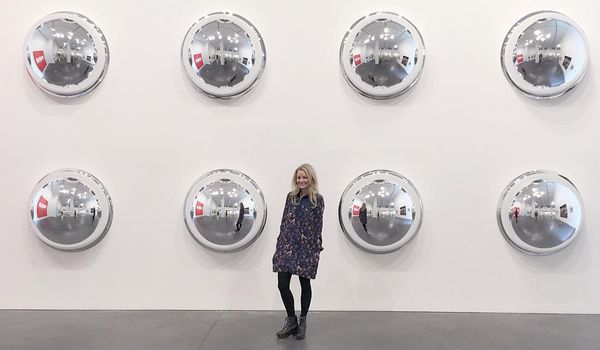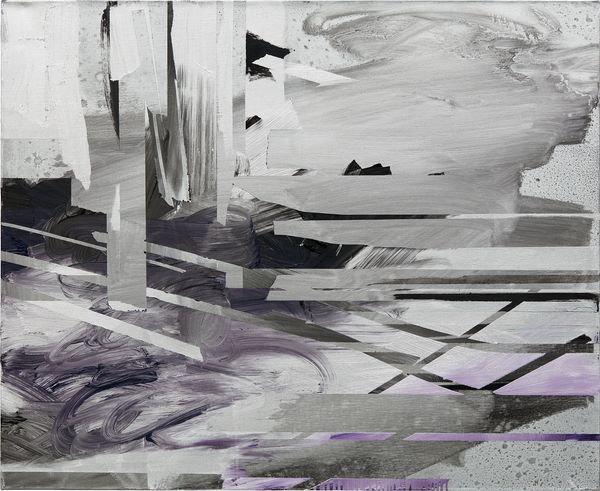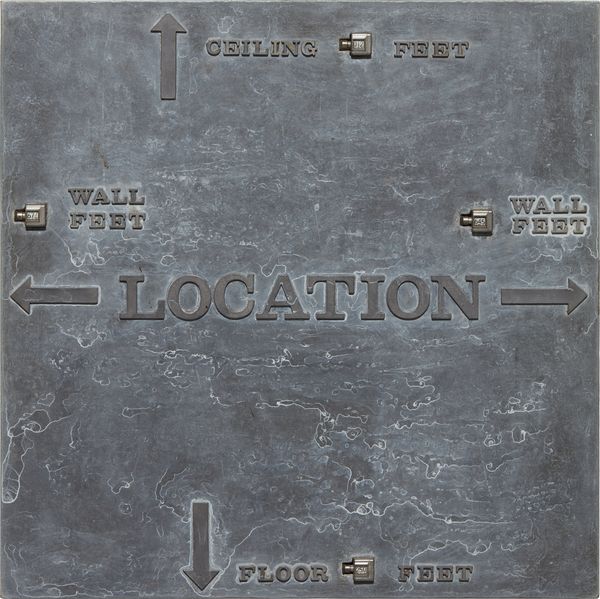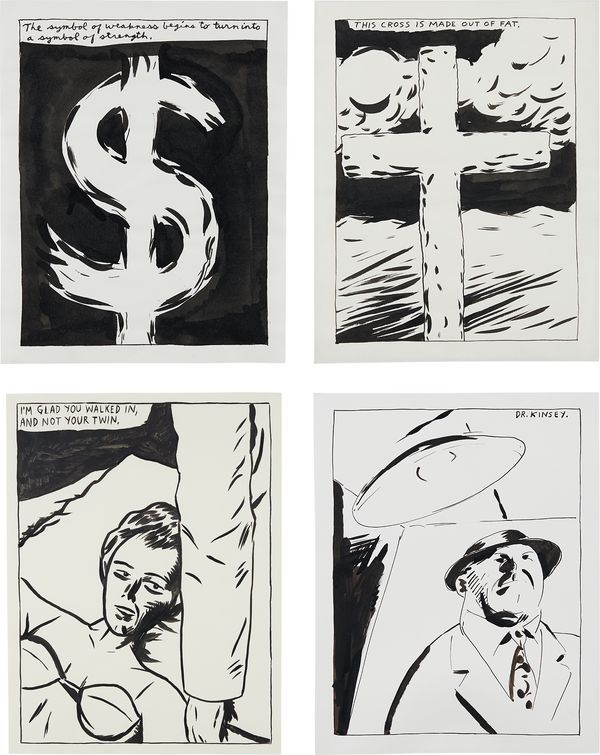Rebekah Bowling in front of John Armleder's Untitled (Global 1), 15 convex acrylic mirrors, 1998 at our New York galleries at 450 Park Avenue
Artsy: New Now is celebrated for featuring artists at the forefront of transforming the contemporary art world. How do you see artists pushing traditional boundaries in this sale?
Rebekah Bowling: A theme that emerged as the sale was coming together was one of female artists challenging male-dominated genres. Jacqueline Humphries came to mind immediately. When she started making work in the 1980s, there was a great deal of antagonism around Abstract Expressionism. She tackled the traditions set forth by the New York School's male figureheads by creating a new, fresh and distinctive gestural iconography.
Jacqueline Humphries Untitled, 2006
I see Keltie Ferris working in this same vein as an artist from a younger generation. While she's been compared to other, predominately male, artists who make references to digital marks in their canvases, her compositions combine the hand-painted and the mechanical in a complex and harmonious way that's all their own.
Petra Cortright might be working in the most highly-gendered realm with her technology-based practice. Her use of Photoshop to create original compositions from stock imagery that we've seen time and time again challenges the use of a program traditionally thought of as a means to create idealized home interiors and dream women.
Keltie Ferris The Producer, 2014
A: Are there any themes or stylistic trends you see repeated across the generations of represented artists?
RB: I'm always so pleased when there are cross-general associations between works in the sale that I get to highlight. I think this feature is one of the most special aspects of New Now and a product of the diverse selection of works in the sale.
For example, we're offering a work from Minimalist master Robert Morris that's part of his "Location" series, a group of 17 unique variations he executed in 1973. Location is a square gray relief rendered in lead with small adjustable meters attached near all four edges. The numbers on the meters correspond to the distance in feet from the work to the nearest walls, ceiling and floor as described by the text and arrows that accompany them. With its colorless, anonymous style and focus on the physical context of its display above everything else, Location challenges expectations of art as a form of expression, one of the core principals of minimalism.
Robert Morris Location, 1973
I think our cover lot, Tauba Auerbach's Slice V from 2013, provides an excellent example of how contemporary artists continue to explore the tenets of this art historical movement. From her series of "Weave" works, Slice V is a monochromatic composition made of strips of canvas repetitively woven together forming a surface that oscillates between projection and recession. The final work resists definition as either a painting or a sculpture and exists in what the artist has coined the "2.5th Dimension" — a space that exists somewhere between what lies in front of us and the space where we exist.
Tauba Auerbach Slice V, 2013
A: Could you highlight some standout works by more established artists for aspiring collectors?
RB: I think a great example from an established artist, which also comes with a really conservative estimate, is Ron Gorchov's Sundial from 1982. It's a quintessential example of one of his distinctively shaped canvases that he's been making since the late '60s in response to the prevailing focus on formalism at the time.
Ron Gorchov Sundial, 1982
A: How about more unusual pieces, or works by emerging or mid-career artists?
RB: In terms of unusual pieces, I can't think of a more "unusual" artist than Mike Kelley, and I'm really excited to be offering one of his felt pieces. He started making these fabric banners in 1987, the year before executing the work in our sale, Cocks and Balls from 1988. This body of work exemplifies the way his practice challenged established notions of gender-normative activities as well as high art and craft culture. These works also draw from Modernist sources like Henri Matisse's cutouts and Alexander Calder's prints and evoke a sort of joyous primitivism.
A: Are there any works in New Now with coinciding institutional exhibitions?
RB: As part of a single-owner section coming from an important Miami collection, we have a group of four Raymond Pettibon works from 1986/1987 in the sale. Pettibon is the subject of an amazing solo exhibition at the New Museum, which opened earlier this month. We also have an iconic Marilyn Minter photograph, Deluge from 2001, which coincides with her first retrospective currently on view at the Brooklyn Museum through 16 April.
Raymond Pettibon Four Works: (i) The Symbol of Weakness Begins To Turn Into A Symbol of Strength (ii) I'm Glad You Walked In, and Not Your Twin (iii) This Cross Is Made Of Fat (iv) Dr. Kinsey, 1987
Marilyn Minter Deluge, 2011
A: How do you anticipate collector preferences from the fall season continuing or evolving as we head into 2017?
RB: I think collectors will continue to be interested in discovering artists associated with lesser-known or forgotten art historical movements, as well as artists from major movements who may have been overlooked.
I think this trend points to both an interest in value and a common desire to form thoughtful collections that explore particular themes across generations.







